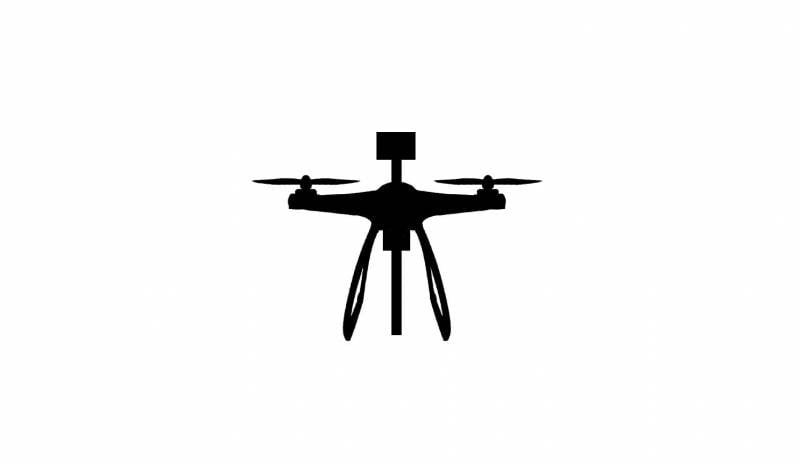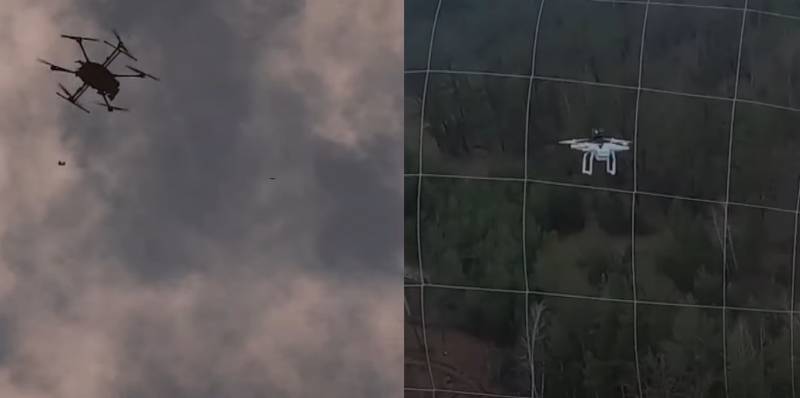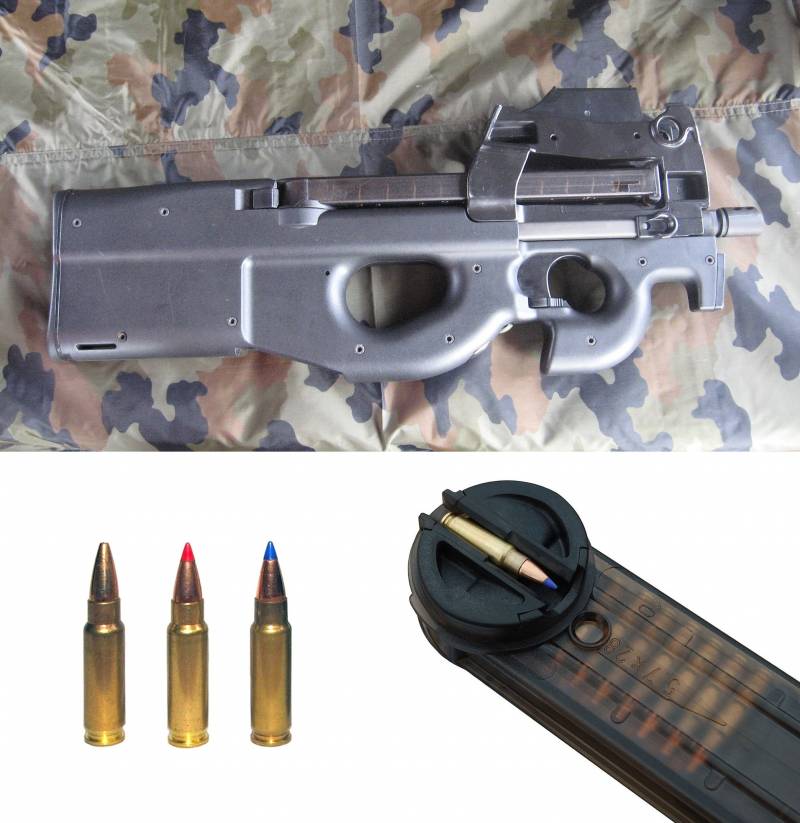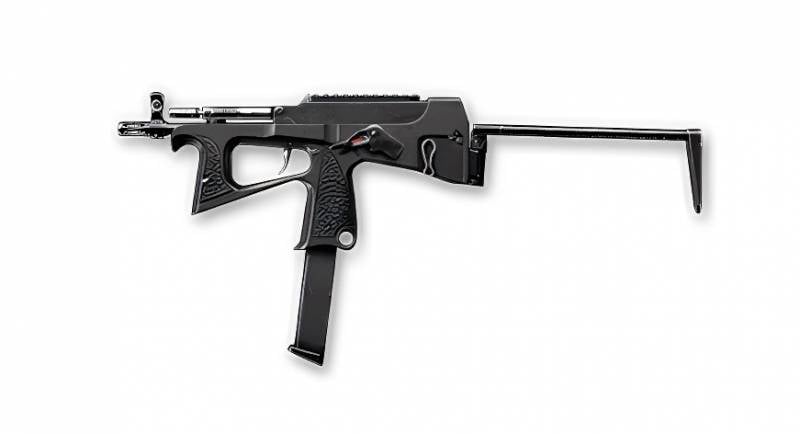Third Person Warfare: Drones vs. Drones

In the material Drones over the trenches: countering reconnaissance quadrocopters and adjustments on the front line we studied the elements of a spatially and functionally distributed anti-drone system designed to destroy enemy unmanned aerial vehicles (UAVs) on the front line.
The considered elements of the complex are designed to defeat drones enemy from the surface. The estimated radius of destruction, that is, the actually protected zone, is of the order of one kilometer. Increasing the distance of an enemy UAV from the surface will require the use of guided munitions, which means it will lead to a complication and rise in the cost of the complex as a whole. In principle, this option can also be considered, but for a number of reasons we will not talk about it.
One of the possible ways to deal with enemy UAVs is to use specialized UAVs equipped with one or another means of destruction, for example, a fixed automatic weapons or net thrower. Also, the defeat of the enemy UAV can be carried out directly by the impact of the attacking UAV with the enemy UAV, that is, the use of kamikaze UAVs is implied.
All of these options have the right to life, but there are certain nuances that can significantly affect their effectiveness.
Controversial decisions
At first - These are anti-drone kamikaze UAVs.
It seems that they can work, but how rational is this in accordance with the cost-effectiveness criterion? In fact, we need all the attributes of a UAV - an engine, a power source, detection tools (a day camera and / or a thermal imager), a control system. And all this in order to hit the same enemy drone?
Even a kamikaze UAV attack on an infantryman can be considered more effective - a trained fighter is much more difficult to find than a new commercial UAV, which the enemy will again purchase and use for reconnaissance on the battlefield.
Secondly, the use of some kind of grids dropped or fixed on the UAV interceptor - all this is somehow unreliable. If the mesh is attached to the attacking UAV, then it has a very real chance of crashing to the ground along with its target. And if the mesh is dropped, then it can be carried by the wind, the attacked UAV can have casings on screws, as a result of which it will continue to fly with the mesh on the body.
No, there are and will be cases of successful use of nets, but with mass use this is not a very reliable means of attacking enemy UAVs.

Ukrainian UAV attacking an enemy UAV with a mesh
Thirdly - this is the use of machine guns and assault rifles, since their capabilities are clearly excessive for defeating small-sized UAVs on the battlefield, and at the same time their weight and size characteristics and the recoil generated during firing are redundant.
In addition, a submachine gun / assault rifle bullet retains its lethal force at a great distance - it is difficult to get into an enemy UAV from such an enemy, but it is quite possible to accidentally hit your own fighters or civilians.

Quadcopter-type UAV armed with an automatic rifle
Quadcopter or aircraft type?
Which UAV can become the most effective hunter of its fellows?
Basically, the choice lies between aircraft and quadrocopter (octacopter, hexacopter, etc.) UAV interceptor scheme.
On the one hand, with a quadcopter-type UAV, it is easier to aim at a maneuverable aerial target.
In addition, a quadcopter-type UAV can take off from almost any point and land on it. This allows you to deploy quadcopter-type UAV interceptors right on the front line.
In turn, an aircraft-type UAV requires a take-off site or a catapult, its landing is associated with the risk of an unsuccessful landing.
On the other hand, aircraft-type UAVs are usually more economical than quadcopter-type UAVs, that is, they can patrol a given area for longer. There are also intermediate options when the UAV performs a vertical takeoff, and then goes into horizontal flight.
It can be assumed that the optimal solution would be a combination of quadrocopter and aircraft types of UAVs that complement each other.
weaponry
As we said above, the use of nets and automatic rifles as weapons is not the best choice, but then what kind of weapon is better to hit enemy UAVs?
Both quadcopter-type UAVs and aircraft-type UAVs operating directly on the front line are most often distinguished by their small dimensions. Therefore, hitting them from a mobile UAV and from a long distance will not work. There are two options - either from the surface: with a sufficiently powerful weapon with a large ammunition load, high accuracy and accuracy, or from a small-sized UAV, but from a relatively short distance.
Presumably, in relation to small-sized UAVs, the use of smooth-bore weapons (shotguns) or submachine guns may be the best solution.
Both types of weapons are optimal for hitting targets at a distance of up to 25 meters, a maximum of up to 50 meters, and more is not required. It is possible that the best option would be to use the so-called PDW (Personal defense weapon) - a personal defense weapon, for example, something like the Belgian FN P90 submachine gun, but this type of weapon has not received distribution in Russia, primarily because due to the lack of appropriate ammunition.

The FN P90 submachine gun is perhaps the best solution for arming UAV interceptors designed to intercept small drones
Shooting down the Geranium with the help of the above weapons will definitely not work, but after all, such a task is not set, since there is no universal weapon, and our goal is precisely small-sized UAVs, mainly of civilian production.
The optimal attack distance of a small-sized UAV from a shotgun or submachine gun, as mentioned above, is about 20–30 meters. As the distance increases, the probability of hitting and the probability of hitting the target will decrease.
What's the best way to place weapons?
Most often, weapons on UAVs are placed under the body, coaxially with the direction of flight, to attack the enemy from the side. However, the option of placing the weapon with the barrel down, to attack the enemy from above, may be considered. This placement method has an advantage - the attacking drone will be higher than the enemy, the attacked target will be as open to defeat as possible, including its propellers - propellers.
It is worth noting that an attack from above, presumably, will be effective only against quadrocopter-type UAVs, while to defeat aircraft-type UAVs, it is more efficient to place the weapon coaxially with the direction of movement of the UAV-interceptor.
Based on the foregoing, we will consider possible options for an enemy UAV interceptor.
UAV interceptor options
Option 1.
UAV quadrocopter type. The weapon should be a smoothbore shotgun with a relatively short barrel, with a choke of 1 mm. The magazine capacity should be 3-5 rounds - it makes no sense anymore, since the UAV patrol time is usually limited to 30-60 minutes, it is doubtful that during this time it will be possible to hit more than two enemy UAVs in one area of responsibility. Ideally, to reduce the mass of weapons, the UAV shotgun barrel can be made of carbon fiber with a steel liner, but this technology has not yet become widespread in Russia.

Composite barrels for powerful rifles - Shotgun barrels can be significantly thinner and lighter
The barrel of the shotgun must be centered on the UAV and point down to attack from above. The UAV control system must be adapted to reduce the thrust at the time of the shot in order to compensate for the recoil that shifts the UAV upwards.
Option 2.
Aircraft-type UAV. Submachine guns of 9x19 mm or 9x21 mm caliber should be used as weapons. The orientation of the weapon is coaxial with the direction of flight.

The PP-2000 submachine gun with a magazine for 44 rounds of 9x19 mm weighs only 1,53 kilograms (without a stock) - the necessary and sufficient lethal power with low weight and recoil
It is possible to take off the UAV vertically, followed by a transition to horizontal flight - such options already exist and seem to be even being created by Russian enterprises of the military-industrial complex (DIC).

An experimental prototype of an aircraft-type UAV armed with a Vepr self-loading shotgun and designed to combat intruder drones, developed by the Almaz-Antey concern
It would seem that the creation of an UAV-interceptor of enemy drones of one type or another is a relatively simple task, especially since, as we see, such products are already being developed, then why are they still not at the front?
Perhaps because it is quite difficult to integrate weapons into a commercial UAV, for example, manufactured by DJI, and there are still very few UAVs that were completely developed in Russia. If this is so, then priority in the manufacture of domestic UAVs should be given specifically to UAV interceptors, since reconnaissance drones and even grenade/min drop drones are quite good from Chinese-made commercial models.
Hunting algorithm
The effectiveness of the actions of UAV interceptors will not be very high without the initial detection of enemy drones and the issuance of target designation to them by the means discussed in the previous material, such as:
- means of electronic intelligence based on SDR receivers;
- means of electronic intelligence based on spectrum analyzers;
- Acoustic reconnaissance equipment.
The actions of UAV-interceptors and ground fire weapons must be coordinated from the ground, both to increase the effectiveness of destroying enemy UAVs, and to minimize the likelihood of defeating their own UAVs.
In other words, UAV interceptors must be integrated into a spatially and functionally distributed anti-drone complex, which we considered in the previous material mentioned at the beginning of the non-standing material. That is, the fight against small-sized UAVs at the forefront should be carried out systematically, with the involvement of various forces and means, with the formation of separate units to solve this problem, which, by the way, is already being done by the Armed Forces of Ukraine (AFU).
The interaction of various elements of a spatially and functionally distributed anti-drone complex should look like this:
- means of electronic and acoustic reconnaissance carry out the initial detection of enemy UAVs at the front line (potentially they can be supplemented by active radar tools, visual detection of enemy drones, undercover intelligence data, etc.);
- means of acoustic and optical reconnaissance carry out additional search, tracking and target designation (if necessary) of the enemy UAV;
- ground-based fire weapons carry out an attack on enemy UAVs;
- in parallel, a quadrocopter-type UAV takes off, enters the enemy UAV location zone and attacks from the upper hemisphere - ground-based weapons at this time suspend the attack to eliminate the possibility of hitting their own UAV;
– while the quadrocopter-type UAV is taking off and climbing, the enemy drone can be attacked by the aircraft-type UAV, if at that moment it is patrolling in this zone;
- Ensuring interaction and adjusting the action of all involved forces and means are carried out by observers of the "second numbers" of ground-based fire weapons.
Thus, each element of a spatially and functionally distributed anti-drone complex increases the likelihood of detecting and destroying an enemy UAV at any given time.
If the enemy UAV is not detected by electronic warfare, then it can be detected by acoustic reconnaissance. If it is not destroyed from the ground, it will be shot down from the air. Not an aircraft-type UAV, but a quadrocopter-type UAV.
Conclusions
As the current reality shows, the importance of solving the problem of combating enemy UAVs is growing more and more - the Armed Forces of Ukraine are already dropping ammunition with toxic substances on the positions of our troops, that is, they are actually using chemical weapons, so it can come to bacteriological weapons - it’s worth it now fear outbreaks of infections in border areas.
The enemy, both preparing for the destruction of Russian UAVs, forming special military units for this, is also massively using their own UAVs, as can be judged by the abundance of enemy “video reports” from Vugledar.
There is an opinion that the best, if not the only way to effectively deal with small-sized enemy UAVs is the use of electronic warfare (EW). However, electronic warfare means are not omnipotent - UAV control channels are becoming more complicated, their noise immunity is increasing. But the worst thing is that the use of electronic warfare equipment can deprive the UAV not only of the enemy, but also of their own units.
However, there are potentially ways to create UAVs that are not affected by electronic warfare - we will talk about this in the next article.
Information